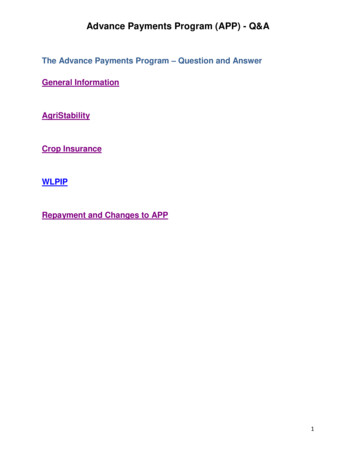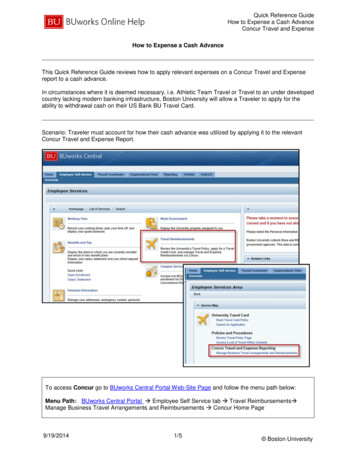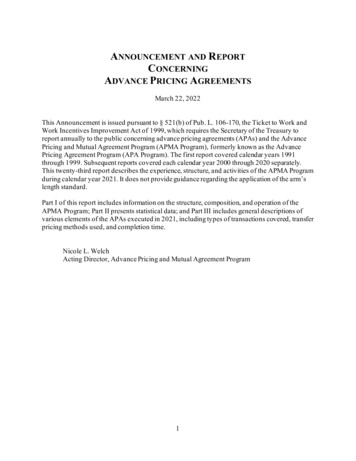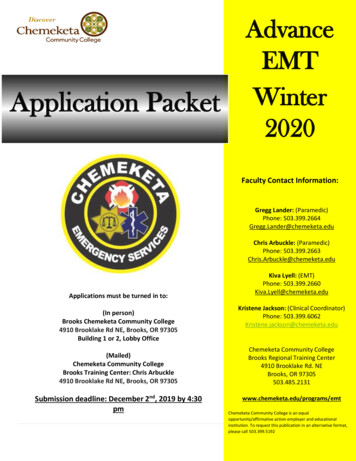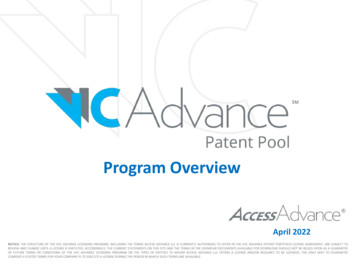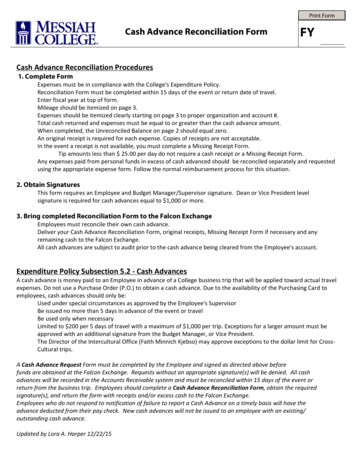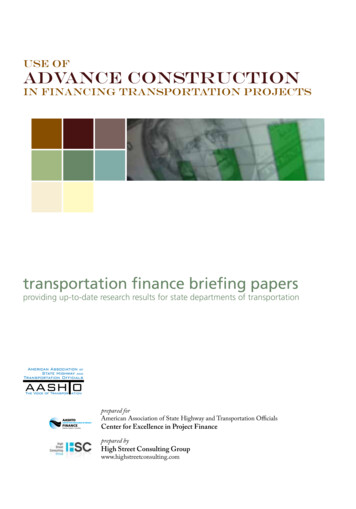
Transcription
Use ofAdvance Constructionin financing transportation projectstransportation finance briefing papersproviding up-to-date research results for state departments of transportationprepared forAmerican Association of State Highway and Transportation OfficialsCenter for Excellence in Project Financeprepared byHigh Street Consulting Groupwww.highstreetconsulting.com
American Association of State Highway and Transportation Officials444 North Capitol Street, NW, Suite 249Washington, DC 20001(202) 624-5800 phone/(202) 624-5806 e.org 2011 by the American Association of State Highway and TransportationOfficials. All rights reserved. Duplication is a violation of applicable law.
Table of ContentsExecutive Summary . . . . . . . . . . . . . . . . . . . . . . . . . . . . . . . . . . . . . . . . . . . . . . . . . . . . . . . . . . . . . . iii1. Introduction . . . . . . . . . . . . . . . . . . . . . . . . . . . . . . . . . . . . . . . . . . . . . . . . . . . . . . . . . . . . . . . . . . 12. Background . . . . . . . . . . . . . . . . . . . . . . . . . . . . . . . . . . . . . . . . . . . . . . . . . . . . . . . . . . . . . . . . . . . 33. Study Methodology . . . . . . . . . . . . . . . . . . . . . . . . . . . . . . . . . . . . . . . . . . . . . . . . . . . . . . . . . . . 74. Historic Trends and Factors Affecting Advance Construction Use. . . . . . . . . . . . . 115. Program Administration. . . . . . . . . . . . . . . . . . . . . . . . . . . . . . . . . . . . . . . . . . . . . . . . . . . . . . 196. Conclusion. . . . . . . . . . . . . . . . . . . . . . . . . . . . . . . . . . . . . . . . . . . . . . . . . . . . . . . . . . . . . . . . . . . 237. Appendices. . . . . . . . . . . . . . . . . . . . . . . . . . . . . . . . . . . . . . . . . . . . . . . . . . . . . . . . . . . . . . . . . . . 25A.1 Case Studies of Interviewed States. . . . . . . . . . . . . . . . . . . . . . . . . . . . . . . . . . . . 25 California . . . . . . . . . . . . . . . . . . . . . . . . . . . . . . . . . . . . . . . . . . . . . . . . . . . . . . . . . 26 Colorado. . . . . . . . . . . . . . . . . . . . . . . . . . . . . . . . . . . . . . . . . . . . . . . . . . . . . . . . . . 27 Florida. . . . . . . . . . . . . . . . . . . . . . . . . . . . . . . . . . . . . . . . . . . . . . . . . . . . . . . . . . . . 28 Idaho . . . . . . . . . . . . . . . . . . . . . . . . . . . . . . . . . . . . . . . . . . . . . . . . . . . . . . . . . . . . . 29 Kansas . . . . . . . . . . . . . . . . . . . . . . . . . . . . . . . . . . . . . . . . . . . . . . . . . . . . . . . . . . . . 30 Louisiana . . . . . . . . . . . . . . . . . . . . . . . . . . . . . . . . . . . . . . . . . . . . . . . . . . . . . . . . . 31 Maryland . . . . . . . . . . . . . . . . . . . . . . . . . . . . . . . . . . . . . . . . . . . . . . . . . . . . . . . . . 32 Michigan. . . . . . . . . . . . . . . . . . . . . . . . . . . . . . . . . . . . . . . . . . . . . . . . . . . . . . . . . . 33 New Jersey . . . . . . . . . . . . . . . . . . . . . . . . . . . . . . . . . . . . . . . . . . . . . . . . . . . . . . . . 34 New Mexico . . . . . . . . . . . . . . . . . . . . . . . . . . . . . . . . . . . . . . . . . . . . . . . . . . . . . . 35 South Dakota . . . . . . . . . . . . . . . . . . . . . . . . . . . . . . . . . . . . . . . . . . . . . . . . . . . . . 36 Tennessee . . . . . . . . . . . . . . . . . . . . . . . . . . . . . . . . . . . . . . . . . . . . . . . . . . . . . . . . . 37A.2 Interview Guide. . . . . . . . . . . . . . . . . . . . . . . . . . . . . . . . . . . . . . . . . . . . . . . . . . . . . . 38A.3 State by State Advance Construction Balances (1997–2010). . . . . . . . . . . 40A.4 Sample State DOT Policies on Advance Construction . . . . . . . . . . . . . . . . 42Use of Advance Construction in Financing Transportation Projects i
Executive SummaryStudy PurposeThrough this briefing paper, Use of Advance Construction in Financing Transportation Projects, the AASHTO Center for Excellence in Project Finance (CEPF)seeks to provide transportation industry professionals with a synthesis of practicesacross the country relating to the use of the Advance Construction (AC) technique. The use of AC across states varies widely—from consistent and aggressiveuse that is an integral part of a state’s financial management to more selective orsporadic use. This briefing paper presents historical trends in AC usage, identifiescurrent practices, benefits, and challenges, and provides observations regardingfuture use and administration of the AC technique.Benefits of Advance ConstructionAdvance Construction is one of several Federal-aid fund management toolsdesigned to provide states with greater flexibility in managing Federal-aid highway funds. The primary benefit of AC is that it allows states to accelerate transportation projects using non-Federal funds while maintaining eligibility to bereimbursed with Federal-aid funds at a later date. Prior to the 1990’s, AC wasused solely as a means to transition between Federal fiscal years. Beginning withthe Intermodal Surface Transportation Efficiency Act of 1991 (ISTEA) and, inparticular, the innovative finance research initiative under FHWA’s test and evaluation program, known as TE-045, in 1994, the AC tool was adjusted to furtherfacilitate advanced project delivery.Considerations and RisksThe AC technique serves one or more of the following functions: Cash management Acceleration of state projectsUse of Advance Construction in Financing Transportation Projects iii
Acceleration of local projects Facilitation of GARVEE debt issuanceThe functions that AC serves in a particular state differ based on the relative levelsof state and Federal funding as well as each state’s overall approach to funding andfinancing transportation projects.Since there is no commitment by FHWA to fund the project, states must carefullyconsider their strategy for utilizing the AC technique and converting projects. IfFederal funds are not available at the time conversion is planned, the state willhave to continue the project with non-Federal funds or suspend any work on theproject. On the other hand, the state is not required to convert the project and maychoose to complete the project without ever requesting Federal funds—a practicethat is commonly applied by many state DOTs.Historical and Current UseNationally, the use of Advance Construction has grown significantly since thelate 1990s (see Chart ES-1). Much of this growth is attributable to the easingof restrictions on the use of AC resulting from TE-045 and the NHS Act. Inrecent years—2008 and 2009—AC balances declined. In 2010, balances remainedconsistent with 2009. According to interviews for this study, the decline in recentyears is at least in part attributable to the September 30, 2009 expiration ofSAFETEA-LU and related reauthorization uncertainty in combination with thecoinciding national economic downturn that is restricting transportation funding in many states. In at least some states, this has resulted in greater and morefrequent AC conversions and more conservative practice regarding the level ofAC balances carried.Chart ES-1. Total AC Balance Nationwide (1997–2010), Dollars in Billions –2010)(1997-2010) 45 40Billions 35 30 30 26 25 22 20 15 10 10 13 16 5 0iv transportation finance briefing papers 34 45 40 36 46 43 38 38
Key FindingsOverall, interviewed states noted few complications with administering theAdvance Construction technique. Based on interviews with 12 states, thefollowing provides a summary of areas that may merit further review with regardto the administration of the AC program. Uncertainty and timing of Federal funding. General uncertainty regardingthe availability of future Federal funding has a significant limiting effect onthe use of the AC technique. Further, end of fiscal year notification regardingthe provision of obligation authority does not enable states to effectively plan,including as it relates to the management of AC. Integration with planning processes. In some states, the manner in which thecoordination between the use of AC and State Transportation ImprovementProgram (STIP) oversight is implemented creates administrative burdens andpotential delays of STIP approval. While the majority of states intervieweddescribed smooth processes, there is an apparent inconsistency across thecountry as it relates to the determination of what level of detail regarding ACprojects is required to be reflected in the STIP, and associated amendmentand timing requirements. This has caused issues in a few states and couldbenefit from further clarification of requirements.Use of Advance Construction in Financing Transportation Projects v
Quality of communication between the state department of transportationand the FHWA Division office. The communication between state DOTs andtheir respective Division offices regarding AC administration was describedas quite strong generally. Instances of poor communication, however, cancreate unnecessary effort or complication for both the state and FHWA. In noinstance did a state point to poor communication as something that adverselyaltered their use of the AC technique. Dated financial systems. A few states expressed that both the state’s financialsystem and FHWA’s Fiscal Management Information System (FMIS) couldbenefit from upgrades that could improve administrative processes in general,not just for the AC program. Interest in technical assistance and information sharing. Interviewed statesexpressed interest in utilizing AC more fully through technical assistance andinformation sharing of best practices. Several noted that they anticipate theresults of this research effort to be a good first step along those lines.In sum, the AC technique is evidenced to be effectively used by states throughoutthe country as both a cash management and project acceleration tool. Based onthe results of this research effort, there are minimal barriers to its use but someopportunities for administrative refinement.vi transportation finance briefing papers
1.0 IntroductionPurpose of the Briefing PaperThrough this briefing paper, Use of Advance Construction in Financing Transportation Projects, the AASHTO Center for Excellence in Project Finance (CEPF)seeks to provide transportation industry professionals with a synthesis of practicesacross the country relating to the use of the Advance Construction (AC) technique. The use of AC across states varies widely—from consistent and aggressiveuse that is an integral part of a state’s financial management to more selective orsporadic use. This briefing paper presents historical trends in AC usage, identifiescurrent practices, benefits, and challenges, and provides observations regardingfuture use and administration of the AC technique.In sum, this briefing paper serves three primary purposes:1. Provides documentation of how broadly and in what ways AC is beingused by state departments of transportation;2. Informs the policy debate about future directions for the AC techniqueby evaluating what is working well and where actual or potential limitations exist regarding the effectiveness of current rules and policies; and3. Documents specific successful practices that other states may be able toapply to improve and expand their use of the AC technique.Research Oversight PanelFollowing are members of the panel that oversaw development of this briefingpaper:Scott Bennett, Assistant Chief Engineer for Planning, Arkansas StateHighway and Transportation DepartmentMichael Bridges, Undersecretary, Office of Management and Finance,Louisiana Department of Transportation and DevelopmentUse of Advance Construction in Financing Transportation Projects 1
Joe Erskine, Deputy Secretary for Finance and Administration,Kansas Department of TransportationLeon E. Hank, Chief Administrative Officer, Michigan Departmentof TransportationReport OrganizationThis Briefing Paper on the Use of Advance Construction in Financing Transportation Projects is divided into six major sections and an appendix. The contents ofeach section and the appendices are described below: Section 1. Introduction. Presents the purpose of the study and the membersof the panel that oversaw development of this briefing paper. Also, introducesthe contents of each section of the briefing paper. Section 2. Background. Describes the technique of Advance Construction,including benefits and uses as well as a history of how use of the tool hasevolved over time. This section also lists resources available for additionalinformation on AC. Section 3. Study Methodology. Summarizes the steps undertaken in conducting the study, including a description of how interview candidates wereselected and the development of the interview guide. A list of state personnelinterviewed is provided. Section 4. Historic Trends and Factors Affecting Advance ConstructionUse. Offers national historic trends in Advance Construction use from 1997through 2010. This section also looks at individual states’ use of AdvanceConstruction, providing average AC use by state since 1997 as well as the topand bottom users of AC in recent years. This section then evaluates a varietyof factors that affect AC in certain states. Section 5. Program Administration. Reviews interviewees’ input on theadministration of the AC program. Section 6. Conclusion. Summarizes the results of the study and, specifically,the input provided by the states as users of the AC technique. This sectionincludes a summary of areas of the AC program that may merit additionalreview. Appendices. Four appendices provide a case study of each of the 12 interviewed states, the interview guide used in discussing AC use with each ofthe interviewed states, data on Advance Construction balances from 1997through 2010 for the states and territories, and sample state DOT policieson Advance Construction provided by a few of the interviewed states.2 transportation finance briefing papers
2.0 BackgroundWhat is Advance Construction?Advance Construction (AC) is a project authorization technique that allowsthe Federal Highway Administration (FHWA) to authorize a project withoutobligating Federal funds. Federal appropriations law requires a Federal agency toobligate the total amount of funds needed to satisfy any commitment made by theagency at the time the commitment is made. In compliance with this requirement,FHWA is required to fully obligate the Federal share of a Federal-aid project atthe time it executes a project agreement. Under an AC authorization, FHWAapproves a project as being eligible for Federal funding but does not committo funding the project. As such, the project must meet all Federal requirementsexcept for the requirement to obligate funds. AC is not a funding category anddoes not provide additional Federal funding.The primary benefit of AC is that it allows states to accelerate transportationprojects using non-Federal funds while maintaining eligibility to be reimbursedwith Federal-aid funds at a later date. Prior to the 1990’s, AC was used solelyas a means to transition between Federal fiscal years. If a state had used all ofits funds in a particular program or all of its obligation limitation it could useAC to advance projects until additional funds were authorized in the new fiscalyear. States were required to convert all AC projects to fully funded status at thebeginning of the Federal fiscal year. As discussed more fully below, beginning withthe Intermodal Surface Transportation Efficiency Act of 1991 (ISTEA) and, inparticular, the innovative finance research initiative under FHWA’s test and evaluation program, known as TE-045, in 1994, the AC tool was adjusted to furtherfacilitate advanced project delivery.Advance Construction is one of several Federal-aid fund management toolsdesigned to provide states with greater flexibility in managing Federal-aid highwayfunds. Typically, state and local governments must provide 5 to 20 percent of theUse of Advance Construction in Financing Transportation Projects 3
funding for projects benefiting from Federal aid. An objective of themanagement tools is to ease restrictions on the timing of obligationsand reimbursements and create a broader range of options for meeting matching requirements. While finding money to fund projectsis always a challenge, states and other project sponsors also have toalign the flow of projects with the availability of funding. These toolsare intended to help non-Federal project sponsors leverage Federalfunding and expedite project implementation.By eliminating the need to set aside full obligational authority beforestarting projects, the AC technique enables a state to undertakea greater number of concurrent projects than would otherwise bepossible. Since there is no commitment by FHWA to fund the project, states must carefully consider their strategy for utilizing the ACtechnique and converting projects. For example, a recent audit of astate DOT found that the Federal share of AC projects was improperly recorded as accounts receivable, requiring the DOT to immediately convert projects and obligate a significant amount of Federalfunds to avoid an end-of-year deficit in state accounts. If Federalfunds are not available at the time conversion is planned, the statewill have to continue the project with non-Federal funds or suspendany work on the project. The state is not required to convert the project and may complete the project without ever requesting Federalfunds—a practice that is commonly applied by many state DOTs.Partial Conversion of Advance Construction (PCAC) was formally authorized inthe Safe, Accountable, Flexible, Efficient Transportation Equity Act: A Legacy forUsers (SAFETEA-LU) but was in practice before the legislative change. PCACenables a state to convert an AC project to a Federal-aid project in stages, basedon cash flow requirements and availability of obligation authority, rather than allat once. Under PCAC, the state converts, obligates, and receives reimbursementfor only a portion of the Federal share of project costs. This removes any requirement to wait until the full amount of obligation authority is available, enablingstates to begin some projects earlier and more effectively manage cash flow. PCACalso is an important technique when used in conjunction with Grant AnticipationRevenue Vehicles (GARVEE bonds) where Federal funds are obligated for debtservice payments over a period of time beyond the completion of construction.History of Advance Construction TechniqueAdvance Construction has been part of the Federal-aid highway program since1956, but beginning with the Intermodal Surface Transportation Efficiency Actof 1991 and, in particular, the innovative finance research initiative under FHWA’stest and evaluation program, known as TE-045 in 1994, the tool was adjusted tofurther facilitate project delivery. In particular, Section 308 of the National Highway4 transportation finance briefing papers
System Designation Act of 1995 (NHS Act) eliminated the requirement thatfuture year authorizations be in effect one year beyond the fiscal year for whichthe AC application was sought. With this change, FHWA can approve an ACproject at any time, provided the project is on the State Transportation Improvement Program (STIP). This provides states with greater flexibility to use ACbased on anticipated apportionmentsbeyond the final year of a FederalAdvance Construction Legislationtransportation funding authorizationTitle 23–Chapter 1act. This flexibility also was important§115. Advance Constructionin making GARVEE bonds feasible.The approval process for an ACa. In General.—The Secretary may authorize a state toor PCAC project in a state’s STIPproceed with a project authorized under this title—includes the following steps1:1. without the use of Federal funds; and1. State identifies project(s)2. in accordance with all procedures and requireand requests AC designaments applicable to the project other than thosetion;procedures and requirements that limit the state2. FHWA Division officeto implementation of a project—ensures project meetsA. with the aid of Federal funds previouslyFederal-aid requirements;apportioned or allocated to the state; or3. FHWA reviews andB. with obligation authority previously allocatedapproves AC designation forto the state.project. Project agreementb. Obligation of Federal Share.—The Secretary, on theexecuted;request of a state and execution of a project agree4. State constructs projectment, may obligate all or a portion of the Federalfollowing Federal-aidshare of a project authorized to proceed under thisrequirements;section from any category of funds for which the5. State requests conversionproject is eligible.to Federal-aid project witha full or partial obligationc. [c. Redesignated d.]and project agreementd. Inclusion in Transportation Improvement Program.—is modified;The Secretary may approve an application for a proj6. FHWA obligates Federalect under this section only if the project is includedaid funds per modifiedin the transportation improvement program of theproject agreement;state developed under section 135 (f).7. State requests reimbursement for costs incurred up tothe amount obligated; and8. FHWA makes payment to the state.More recently, in 2005, SAFETEA-LU enabled all categories of Federal-aidhighway funds to be eligible for AC. Additionally, a clarification was announced inFederal Highway Administration, Office of Innovative Program Delivery: Innovative Finance. Toolsand Programs: Federal Aid Fund Management Tools.1Use of Advance Construction in Financing Transportation Projects 5
Advance Construction Resources Statutory Reference: 23 USC §115 Code of Federal Regulations Reference: 23 CFR 630G Federal Highway Administration, Office of Innovative Program Delivery:Innovative Finance. Tools and Programs: Federal Aid Fund Management Tools.http://www.fhwa.dot.gov/ipd/index.htm Federal Highway Administration, Office of Program Administration.A Guide to Federal-Aid Programs and Projects. Updated March 11, e inactive.cfm. Federal Highway Administration, Office of Planning, Environmental, and Realty.Guidance on Financial Planning and Fiscal Constraint for Transportation Plans andPrograms. April 17, 2009. the Federal Register on August 26, 2008 (Docket No. FHWA-2007-0020)that eliminated the restriction that a state must obligate all of its allocated orapportioned funds, or demonstrate that it will use all obligation authority allocated to it for Federal-aid highways and highway safety construction, prior to theapproval of AC projects. The regulation contains no AC limitation beyond thestatutory requirement that all projects must be on the STIP. This change in regulations was consistent with the revisions in SAFETEA-LU. The existing AdvanceConstruction related legislation (Title 23 USC §115) is provided in the text boxabove. Below are a number of resource documents related to the application ofthe AC technique.As the AC mechanism has evolved over the years so has the use of AC by thestates. As is noted throughout this briefing paper, the AC technique has grownfrom a moderately used cash management tool by many states to a more activemechanism that plays a significant role in accelerating projects. While there is stillroom for improvement as outlined in Section 5 of this briefing paper, almost everystate regularly uses the AC technique to some degree to the benefit of its overalltransportation program.6 transportation finance briefing papers
3.0 STUDY METHODOLOGYMethodology OverviewTo meet the objectives of this research study, a select group of states was interviewed regarding their use of the Advance Construction technique. To determinean appropriate sampling of states with a mix of experiences with the AC techniquefor these interviews, the research team analyzed FHWA data on AC balances. Themethodology for the study can be summarized into the following steps.1. The research team worked with FHWA to query FHWA’s financialdata system for historical AC balance information by state and programcategory.2. The research team consulted with the oversight panel to select state interview candidates based on an analysis of historical AC usage levels andindustry knowledge of states’ AC management practices.3. The research team developed an interview guide covering a range oftopics, including use trends and influences, program and project affects onAC use, AC use in conjunction with debt, program administration, andinstitutional factors.4. The research team conducted interviews with 12 state transportationagencies, including personnel from various departments that togetherhave responsibilities for managing the AC technique.5. The research team consulted with FHWA regarding some study findingsto clarify findings and to help identify areas for potential improvement inmanagement and use of the AC technique.Additional detail on the methodology undertaken in conducting this research isprovided below.Use of Advance Construction in Financing Transportation Projects 7
Analysis of Historical Use Data andSelection of Interview CandidatesIn consultation with the oversight panel, the research teamselected interview candidates based on each state’s levelof AC use, seeking a mix of light, moderate, and heavyAC users as well as other factors such as the use of debtin conjunction with AC and other innovations. Given theimpact that the size of a state’s transportation fundingprogram has on its aggregate volume of AC, the researchteam analyzed the use of AC relative to each state’s formula obligation limit, based on 2009 data, to scale results toindividual state size.The level of a state’s use of AC was based on data obtainedfrom FHWA’s Office of the Chief Financial Officer viaqueries of the Fiscal Management Information System(FMIS). The data provided each state’s AC balances byprogram category as of September 30 for 2008, 2009, and2010. In addition, FHWA provided AC balances by state(but not broken down by program category) as of September 30 for 1997 through 2007.Interviewed StatesBased on the research team’s analysis of the state by stateAC balance data obtained from FHWA’s Office of theChief Financial Officer and additional industry knowledge of particular state innovations with regard to AC, theresearch team proposed interview candidates for reviewby the project panel. Table 3.1 provides a list of the statesselected for interviews and the staff who participated inthe interview. The research team is grateful for the participation and responsiveness of these individuals.Development of InterviewGuide and InterviewsTo provide a framework for the interviews, the researchteam developed an Interview Guide. The Interview Guideincludes a range of questions organized into categoriesregarding AC use and trends, program and project basisfor AC use, AC use and debt, and program administration and institutional factors that affect AC use. Please seeAppendix A.2 for the complete Interview Guide.8 transportation finance briefing papers
Table 3.1 Interviewed StatesStateContactCaliforniaStephen Keck, Chief, Division of Budgets and Fardad Falakfarsa, Chief, Office of FederalResourcesColoradoDarrell Johnson, Construction Budget & Project Funding—Manager, Office of FinancialManagement and BudgetFloridaMarsha Johnson, Director, Office of Financial Development; Mina Ehsani, Supervisor—Resource AllocationIdahoDave Tolman, Administrator, Division of AdministrationKansasJoe Erskine, Deputy Secretary for Finance and Administration; Marcia Ferrill, Director ofFinancial Services; Bruce Burditt, Division of Financial Services, Office of Financial andInvestment Management; Alicia Johnson, Financial and Legislative Policy Analyst; andReed Davis, Manager of Economic AnalysisLouisianaMichael Bridges, Undersecretary, Office of Management and FinanceMarylandDavid Fleming, Chief Financial Officer Maryland DOT; Betty Connors, Director ofFinance, State Highway Administration; Connie Kennedy, State Highway Administration; June Hornet, Maryland DOTMichiganLeon E. Hank, Chief Administrative Officer; Myron Frierson, Director, Bureau of Financeand Administration; Ed Timpf, Administrator, Financial Operations Division, Bureau ofFinance and AdministrationNew JerseyDavid Kuhn, Executive Director, Capital Investment StrategiesNew MexicoMax Valerio, Deputy Secretary for Programs and InfrastructureSouth DakotaLeah DeMers; Jerry Ortbahn, Office of Planning and ProgramTennesseeChris Christensen, Transportation Administrator, Engineering Bureau; Ronnie Porter,Project ProgrammingThe Interview Guide was provided to the interviewees in advance to ensureappropriate personnel participated in the interview and also to give the state timeto obtain responses to more detailed questions. To avoid any undue burden on thestates, written responses were not requested, but some interview contacts elected toprovide written responses to complement the phone discussions.Sections 4, 5, and 6 of this briefing paper provide a synthesis across all interviewedstates with some state-specific examples. Appendix A.1 provides a brief case studyof each interviewed state with a summary of the state’s level of use of AC as wellas the general approach to AC use that the state follows.Use of Advance Construction in Financing Transportation Projects 9
FHWA ConsultationsIn addition to interviewing select states, theresearch team contacted FHWA personnel fortheir perspective on how use and administration of the AC technique has evolved over theyears. As discussed above, FHWA’s Office ofthe Chief Financial Officer was instrumental inproviding th
Use of Advance Construction in Financing Transportation Projects iii Study Purpose Through this briefing paper, Use of Advance Construction in Financing Transporta- tion Projects, the AASHTO Center for Excellence in Project Finance (CEPF) seeks to provide transportation industry professionals with a synthesis of practices

